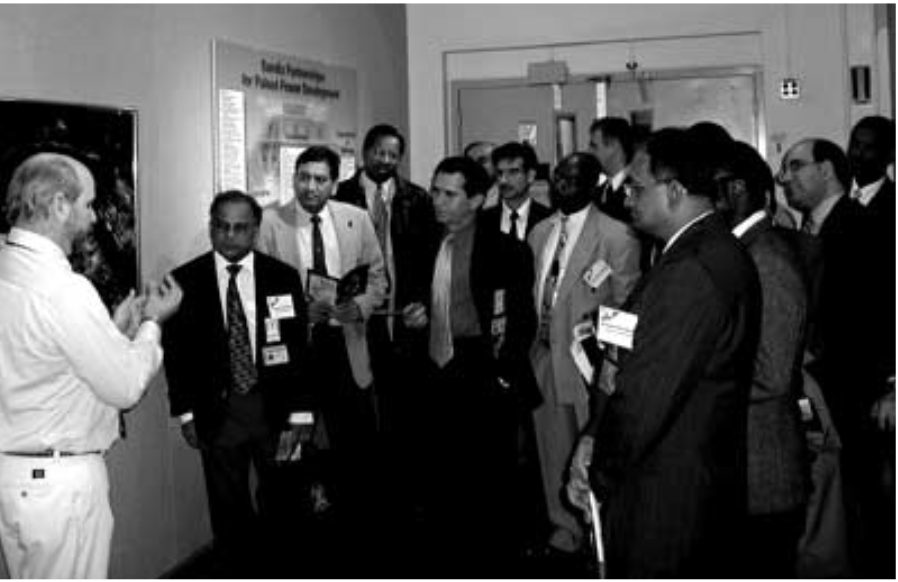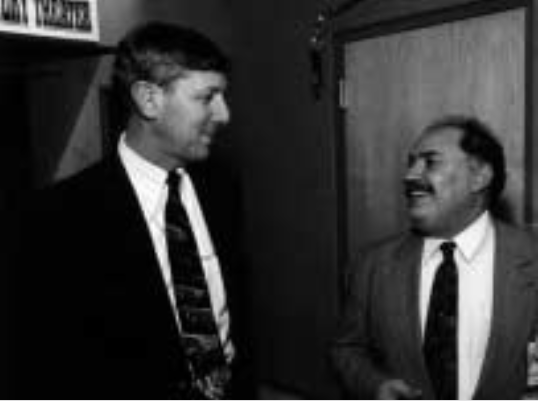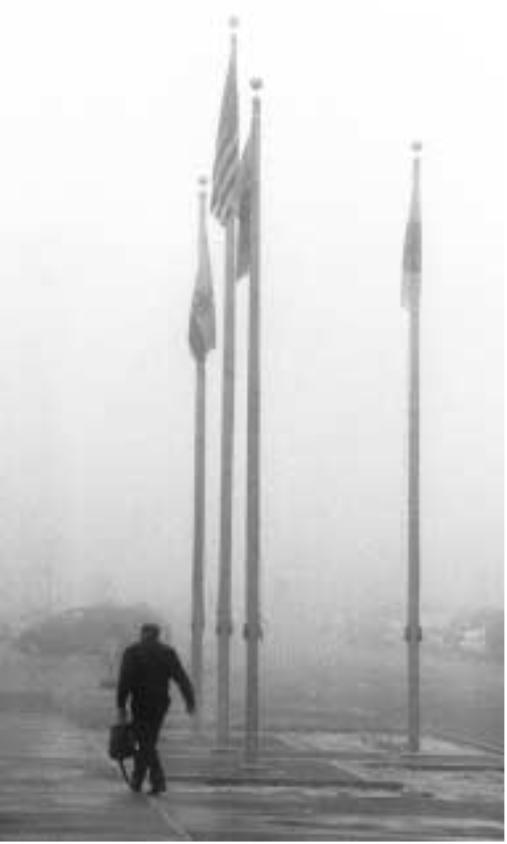The time for talk is over and the time for action is here.So says Chuck Meyers (1030), the new coordinator of the Campus Executive Program.“We’ve spent three years building a foundation with deans and others from the participating universities,” Chuck says. “We now want to implement what we’ve been discussing all this time — more joint research, more graduate students coming to Sandia to work as interns and eventual employees, more interaction between the university faculty members and our staff, and more collaboration.”The Campus Executive Program was established in1997 by Dan Hartley,retired Laboratory Development VP, and Charlie Emery, recently retired Human Resources VP, in an effort to pair Labs executives,called Sandia Cam-pus Execs, with deans from engineering schools across the country.

The Campus Execs and deans worked together to figure out ways the universities and Sandia could be partners — both in recruiting top students from the schools to the Labs and in cooperative research. Sandia, Chuck says, has always valued its relationships with universities — realizing that they are a source of future Labs engineers and scientists and that the universities conduct top-notch research in areas in which Sandia has specific interests.In 2000 Sandia spent$28 million in joint research projects with universities. (Sandia works with 120 universities annually and has 700active contracts with them.) The Labs has devoted an additional$15 million a year for graduate student support and university and science outreach. Chuck and others involved in the program have been looking at creative ways to better lever-age that money so that both the universities and Sandia get what they need out of these collaborative arrangements.
“The deans tell us that they want more joint research and more graduate students gaining experience here,” Chuck says. “We want to use the universities to help us build our technologies and to recruit the best talent in the country.”The first question is, how do you know which schools have the expertise and the graduate students doing the types of research Sandia requires?“We pretty much traditionally turned to the major universities with good reputations — the Harvards, Stanfords, and such,” Chuck says. “But now we are using a new tool.” The tool, VxInsight™, creates a map of research that Sandia uses to determine what schools are “hot and which are not” in different areas.
It is based on data provided by the Institute for Scientific Information tracking science/technical articles in the top 10 percent of scientific journals worldwide.“It may be that a less-known school has a great department in some technology we a reinterested in,” Chuck says. “We can now think about identifying and collaborating with those departments.”Still, the Sandia Campus Executive Program focuses on many of the major-name institutions,plus a few additional schools due to regional proximity and/or quality of underrepresented student enrollment. (See “Campus Exec program participating schools,” next page.) Relationships and programs with each of the universities vary.
“10 years from now I wouldn’t be surprised to see 10 percent of our employees working at universities.”
Schools like the University of Utah, University of Colorado, and Arizona State,for example, are developing fellowships for doctoral students doing research in areas in which the Labs has an inter-est. Sandia awards the student a fellow-ship, and a Sandian is a member of the student’s doctoral committee.“This arrangement has many pluses,” Chuck says.“The students know that their fellowships and research are funded by Sandia, making them aware that the Labs might be a great place to work. With the Sandian on the doctoral committee, the Labs builds up relation-ships with other professors and with the students and offers direct input in the research direction. ”At other universities, Sandia contracts with the institution where the scientists do research.

And at yet others, faculty members will take a sabbatical or summer research appointment and come to Sandia for two months to a year to work directly with researchers here or a Labs scientist will go to a university to spend time there.Chuck says he sees this going even further.“In ten years from now I wouldn’t be surprised to see 10 percent of our permanent employees actually working at the universities doing research and telecommuting,” he says. Based on desires from several Campus Executives to make as large an impact as possible on their assigned campuses, a new initiative in Sandia’s Staffing Organization is attempting to parlay existing relationships into a more strategic stance. “We have long-standing relationships at many levels, from the University president’s office to the researchers’ lab, Sandians who serve on committees and advisory councils, even former staff now serving as Deans or faculty at several schools,” says Lenny Martinez, the Campus Execfor Arizona State and UTEP.
“We need to better manage those alliances so they connect into a cohesive strategy that serves both institutions over the long term.” Frank Figueroa, CU-Boulder Campus Exec,adds, “Universities are key to establishing a world-class workforce. By using our research collaborations and our student programs, from internships to graduate fellowships, we can foster the type of top-notch talent that we need for the Labs. I’m very pleased with the top-to-bottom,end-to-end connections we have forged with the University of Colorado.Don Blanton, VP for Human Resources,explains that the new initiative will influence how Sandia does business with universities. “Our relationship is more of a partnership,with both partners in a win-win situation.” Don says.
“Universities get research dollars, access to the unique research capabilities of Sandia, and training for faculty and students. We gain access to research that supports our mission and an emerging talent pool. Both partners enhance their and the country’s competitiveness. ”The initiative starts by conducting a full inventory of existing relationships between Sandia and a given university. This includes research collaborations, recruiting efforts, special initiatives, alumni(both Sandians who graduated from the school as well as former Sandians working at the school),intern and co-op students, and graduate fellows.Then an action plan is drawn with input from the school, which includes a shared vision, long-term goals, and short-term objectives.
The Sandia vice presidents and other executives who serve as Campus Execs continually build relationships with their assigned universities, visiting the schools’ campuses, and inviting deans and faculty members to the Labs. For the past two years Sandia hosted Deans’ Day in January in which all the deans from the represented universities came to the Labs for tours and dialogue. This year’s Deans’ Day, which will be renamed University Day, will be held in early August in conjunction with Sandia’s annual Student Internship Program Symposium.“Building these relationships with the deans,their faculty, and their top students is one of the best recruiting tools Sandia has.” Chuck says.“Through the Campus Executive Program, we get world-class research and top future employees.”
North Carolina A&T success story
One of the biggest success stories in the Campus Executive Program is Sandia’s relationship with North Carolina A&T State University, a historically black university in Greensboro, N.C.This past December, 16 faculty members and administrators from the university visited Sandia and toured Labs facilities. They met one-on-one with Labs executives, department managers, and principal investigators to discuss mutual research interests and areas of collaborations. “It was a real success,” says Charlie Emery, who has served as Sandia’s Campus Exec to the university for the past three years. “We spent three days with them and shared much information.

This demonstrated to us that they had a sincere interest in establishing more research collaborations.”Charlie, former Human Resources VP who recently retired, says the visit grew out of an earlier trip he, Bill Guyton (15300), Ken Holley (3535), and Tom Bickel (9100) made to North Carolina A&T to build relations and see how Sandia and the university could better collaborate. Replacing Charlie in the role of Campus Exec representative to North Carolina A&T is Bill, Director of Applied Physics &Technical Development Center15300.
He says he sees this as an opportunity to build an even closer relationship with the university— both in collaborative research and as a source for future employees.“Through the visit we became more familiar with each other,” he says. “This type of relationship will move us further into the pipeline for student interns and future employees.”Bill says he has asked several of his principal investigators and program managers to work with faculty from North Carolina A&T to determine where the two institutions can collaborate. Bill has visited the university twice and will become a member of the Advisory Board of the School of Engineering and the School of Fine Arts,which contains the mathematics department.

He is building close relationships with Philip Carey, the university’s Dean of the College of Arts and Science and Reza Salami, Professor and Associate Dean for Graduate Research Programs in the College of Engineering. The relationship with North Carolina A&T started through a DOE science and technology alliance program in 1989. DOE made funding avail-able for the three weapons labs to build science and technology programs at four minority universities. Sandia worked with North Carolina A&T to establish a doctoral program in electrical and mechanical engineering.
“We’ve had a great 10-year relationship with the university,” says Ken. “We’ve helped them with curricula and laboratory development for the PhD program. Their students have been involved in our internship programs. We visit their faculty and they come here. We sit on their boards and we provide research opportunities.”Between 1998 and 2001, Charlie Emery established a set of goals and objectives for the relationship. Each year was evaluated to determine successes. Sandia’s successes included: 20 student interns and five full-time hires. Four faculty members have come to Sandia for sabbaticals. Also, there have been five Sandia executive visits to the university and three North Carolina A&T executive visits to the Labs.
Campus Exec program participating schools
Currently 29 schools participate in the Campus Executive Program. They are:Arizona State, Caltech, Carnegie-Mel-lon, Cornell, Florida State, Georgia Tech,Harvard, Howard, Lehigh, MIT, New Mexico Institute of Mining and Technology, New Mexico State, North Carolina A&T, Purdue,Stanford, Texas A&M, UC Berkeley, UC Davis, University of Arizona, University of Colorado at Boulder, University of Florida,University of Illinois, University of Michigan, University of New Mexico, University of Texas – Austin, University of Texas at El Paso, University of Utah, University of Wisconsin, and Washington State.